Calculus 1A Assignment Solution: Question, Solution, and Analysis
VerifiedAdded on 2020/05/11
|20
|515
|63
Homework Assignment
AI Summary
This document provides a comprehensive solution to a Calculus 1A assignment. The assignment covers a range of calculus topics, including the application of product and quotient rules, the determination of absolute and local maxima and minima, and the analysis of function behavior through derivatives. The solutions include step-by-step explanations, application of the mean value theorem, the use of L'Hopital's Rule for indeterminate forms, and the sketching of curves based on given conditions. Furthermore, the assignment addresses integral calculus and proves a specific function's properties using the mean value theorem. The document offers a detailed breakdown of each problem, providing students with a thorough understanding of the concepts and methodologies involved.
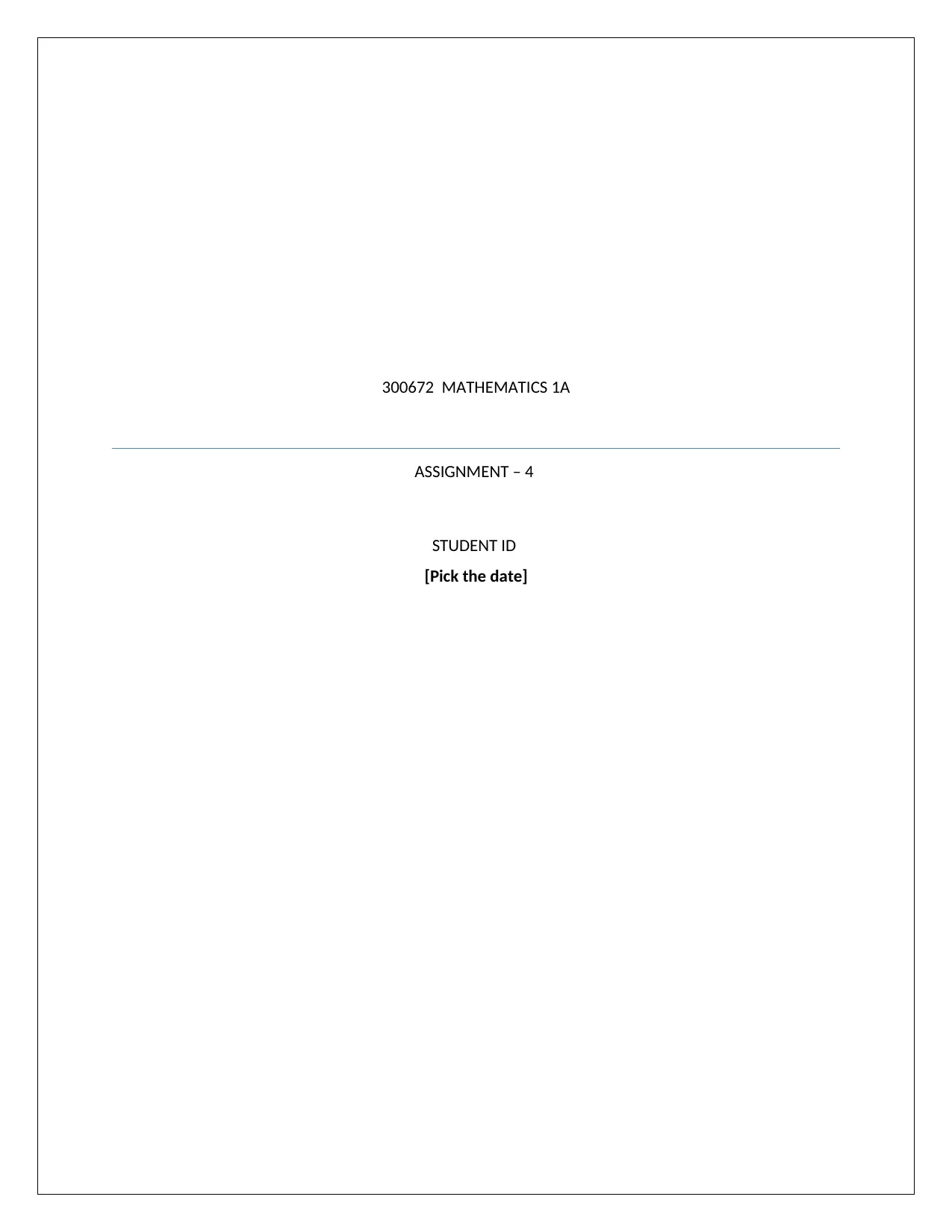
300672 MATHEMATICS 1A
ASSIGNMENT – 4
STUDENT ID
[Pick the date]
ASSIGNMENT – 4
STUDENT ID
[Pick the date]
Paraphrase This Document
Need a fresh take? Get an instant paraphrase of this document with our AI Paraphraser
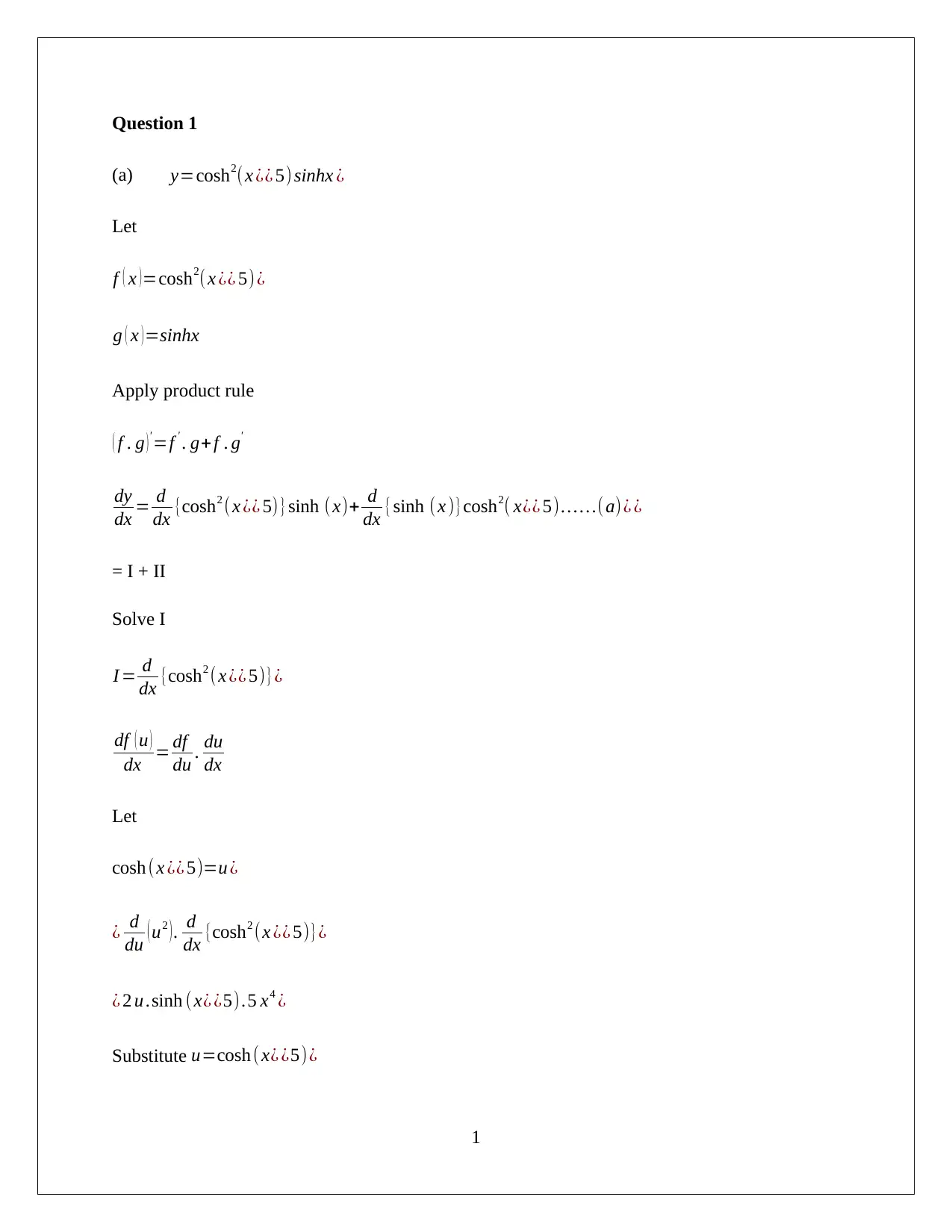
Question 1
(a) y=cosh2( x ¿¿ 5) sinhx ¿
Let
f ( x )=cosh2( x ¿¿ 5)¿
g ( x )=sinhx
Apply product rule
( f . g ) ' =f ' . g+ f . g'
dy
dx = d
dx {cosh2 (x ¿¿ 5)}sinh ( x)+ d
dx {sinh (x )}cosh2( x¿¿ 5)… …(a)¿ ¿
= I + II
Solve I
I = d
dx {cosh2 (x ¿¿ 5)}¿
df ( u )
dx = df
du . du
dx
Let
cosh ( x ¿¿ 5)=u ¿
¿ d
du ( u2 ) . d
dx {cosh2 (x ¿¿ 5)}¿
¿ 2 u .sinh ( x¿ ¿5).5 x4 ¿
Substitute u=cosh ( x¿ ¿5)¿
1
(a) y=cosh2( x ¿¿ 5) sinhx ¿
Let
f ( x )=cosh2( x ¿¿ 5)¿
g ( x )=sinhx
Apply product rule
( f . g ) ' =f ' . g+ f . g'
dy
dx = d
dx {cosh2 (x ¿¿ 5)}sinh ( x)+ d
dx {sinh (x )}cosh2( x¿¿ 5)… …(a)¿ ¿
= I + II
Solve I
I = d
dx {cosh2 (x ¿¿ 5)}¿
df ( u )
dx = df
du . du
dx
Let
cosh ( x ¿¿ 5)=u ¿
¿ d
du ( u2 ) . d
dx {cosh2 (x ¿¿ 5)}¿
¿ 2 u .sinh ( x¿ ¿5).5 x4 ¿
Substitute u=cosh ( x¿ ¿5)¿
1
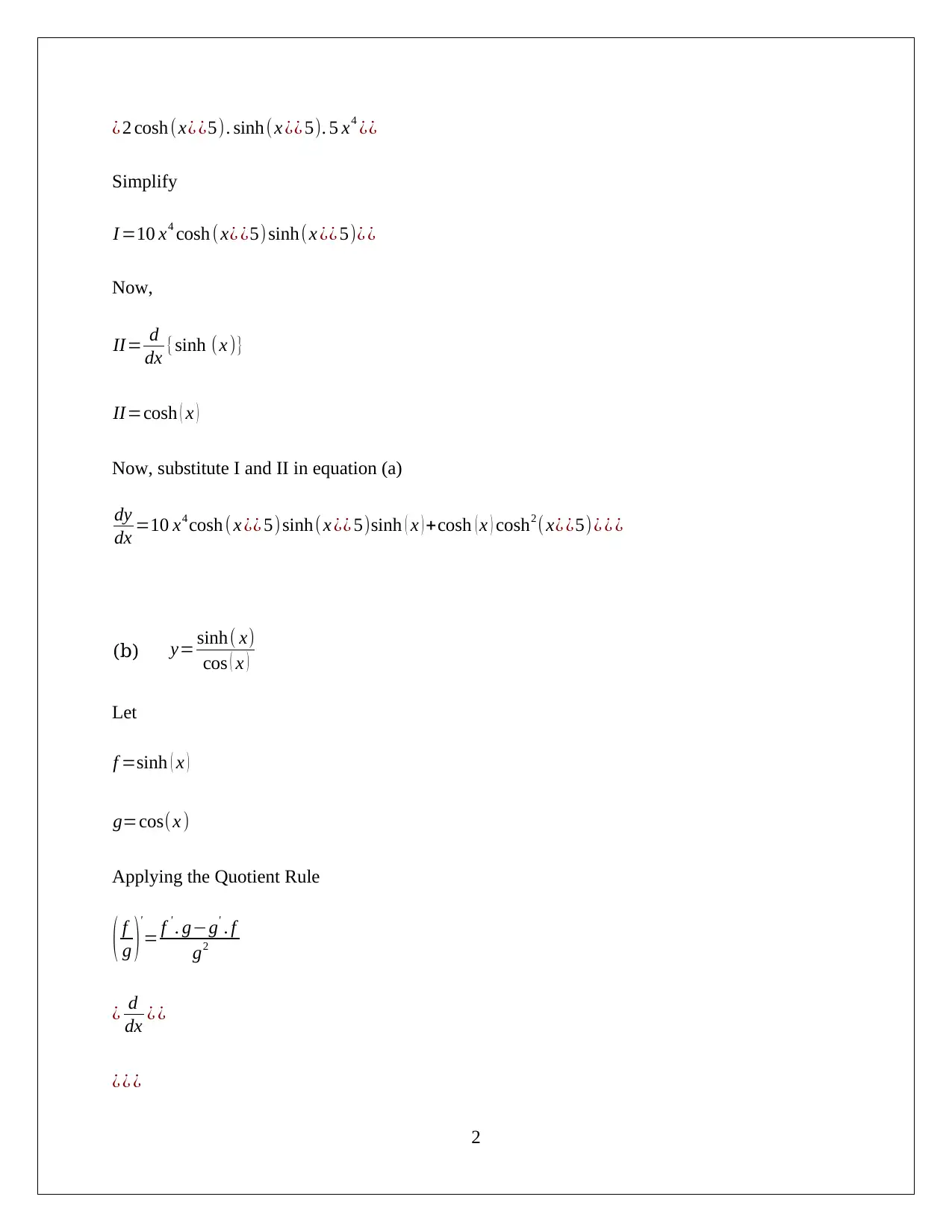
¿ 2 cosh (x¿ ¿5). sinh(x ¿¿ 5). 5 x4 ¿¿
Simplify
I =10 x4 cosh ( x¿ ¿5) sinh(x ¿¿ 5)¿ ¿
Now,
II= d
dx {sinh (x )}
II=cosh ( x )
Now, substitute I and II in equation (a)
dy
dx =10 x4 cosh ( x ¿¿ 5)sinh( x ¿¿ 5)sinh ( x ) +cosh ( x ) cosh2 ( x¿ ¿5)¿ ¿ ¿
(b) y= sinh( x)
cos ( x )
Let
f =sinh ( x )
g=cos(x )
Applying the Quotient Rule
( f
g )'
= f ' . g−g' . f
g2
¿ d
dx ¿ ¿
¿ ¿ ¿
2
Simplify
I =10 x4 cosh ( x¿ ¿5) sinh(x ¿¿ 5)¿ ¿
Now,
II= d
dx {sinh (x )}
II=cosh ( x )
Now, substitute I and II in equation (a)
dy
dx =10 x4 cosh ( x ¿¿ 5)sinh( x ¿¿ 5)sinh ( x ) +cosh ( x ) cosh2 ( x¿ ¿5)¿ ¿ ¿
(b) y= sinh( x)
cos ( x )
Let
f =sinh ( x )
g=cos(x )
Applying the Quotient Rule
( f
g )'
= f ' . g−g' . f
g2
¿ d
dx ¿ ¿
¿ ¿ ¿
2
⊘ This is a preview!⊘
Do you want full access?
Subscribe today to unlock all pages.

Trusted by 1+ million students worldwide
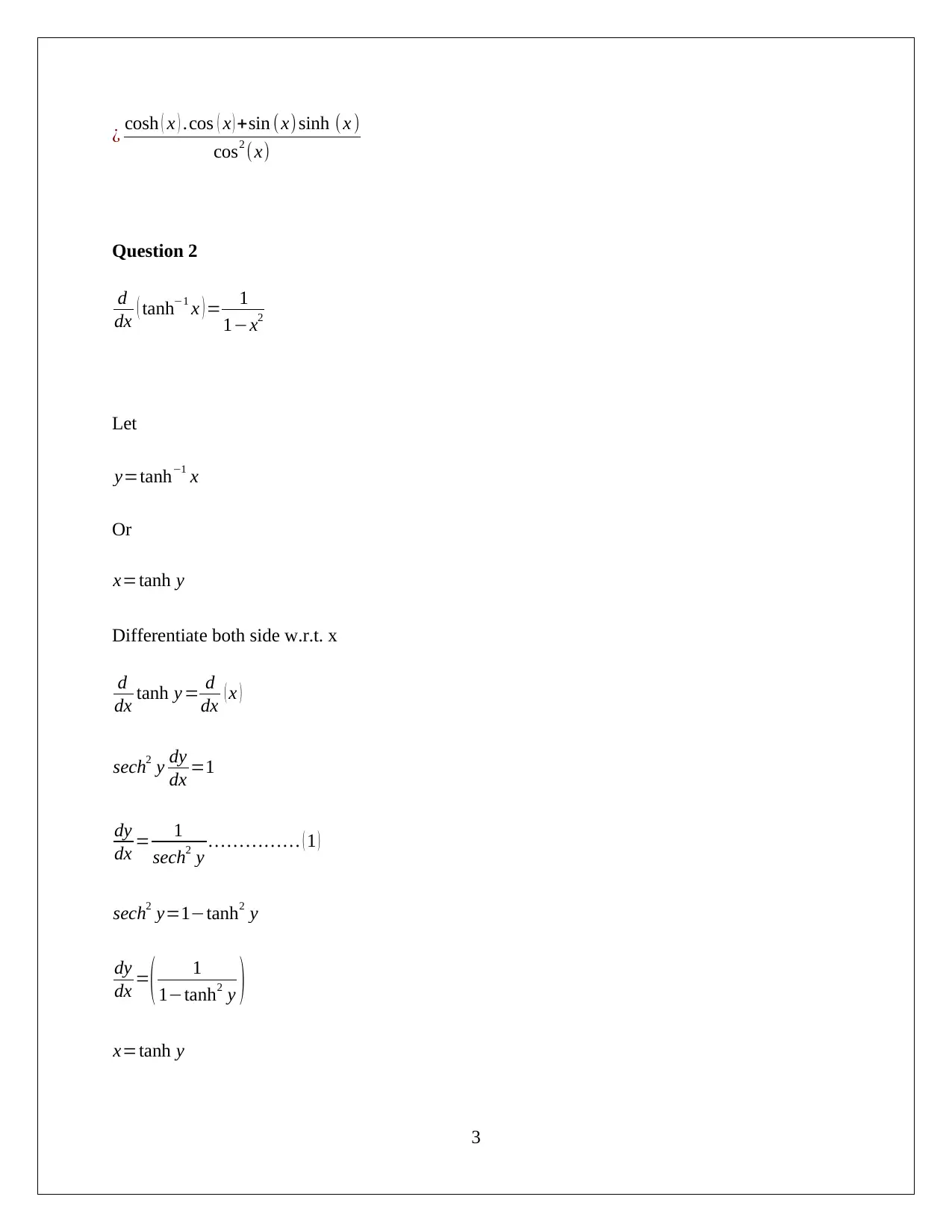
¿ cosh ( x ) .cos ( x ) +sin (x) sinh (x )
cos2 (x)
Question 2
d
dx ( tanh−1 x ) = 1
1−x2
Let
y=tanh−1 x
Or
x=tanh y
Differentiate both side w.r.t. x
d
dx tanh y = d
dx ( x )
sech2 y dy
dx =1
dy
dx = 1
sech2 y … … … … … ( 1 )
sech2 y=1−tanh2 y
dy
dx =
( 1
1−tanh2 y )
x=tanh y
3
cos2 (x)
Question 2
d
dx ( tanh−1 x ) = 1
1−x2
Let
y=tanh−1 x
Or
x=tanh y
Differentiate both side w.r.t. x
d
dx tanh y = d
dx ( x )
sech2 y dy
dx =1
dy
dx = 1
sech2 y … … … … … ( 1 )
sech2 y=1−tanh2 y
dy
dx =
( 1
1−tanh2 y )
x=tanh y
3
Paraphrase This Document
Need a fresh take? Get an instant paraphrase of this document with our AI Paraphraser

dy
dx =
( 1
1−x2 )
Put
y=tanh−1 x
d
dx (tanh ¿¿−1 x)= ( 1
1−x2 ) ¿ Proved
Question 3
Absolute maximum and minimum value of f ( x)=?
f ( x )=4 x
2
7 + x
9
7 , closed interval [ −1 , 1 ]
Now,
f ( x )=4 x
2
7 + x
9
7
Take first derivative of both the sides
f ' ( x ) =4 × ( 2
7 ) x
2
7 −1
+( 9
7 ) x
9
7 −1
f ' ( x ) = 8
7 x
−5
7 + 9
7 x
2
7
Take f ' ( x )=0
f ' ( x )= 8
7 x
−5
7 + 9
7 x
2
7 =0
8
7 x
−5
7 + 9
7 x
2
7 =0
4
dx =
( 1
1−x2 )
Put
y=tanh−1 x
d
dx (tanh ¿¿−1 x)= ( 1
1−x2 ) ¿ Proved
Question 3
Absolute maximum and minimum value of f ( x)=?
f ( x )=4 x
2
7 + x
9
7 , closed interval [ −1 , 1 ]
Now,
f ( x )=4 x
2
7 + x
9
7
Take first derivative of both the sides
f ' ( x ) =4 × ( 2
7 ) x
2
7 −1
+( 9
7 ) x
9
7 −1
f ' ( x ) = 8
7 x
−5
7 + 9
7 x
2
7
Take f ' ( x )=0
f ' ( x )= 8
7 x
−5
7 + 9
7 x
2
7 =0
8
7 x
−5
7 + 9
7 x
2
7 =0
4
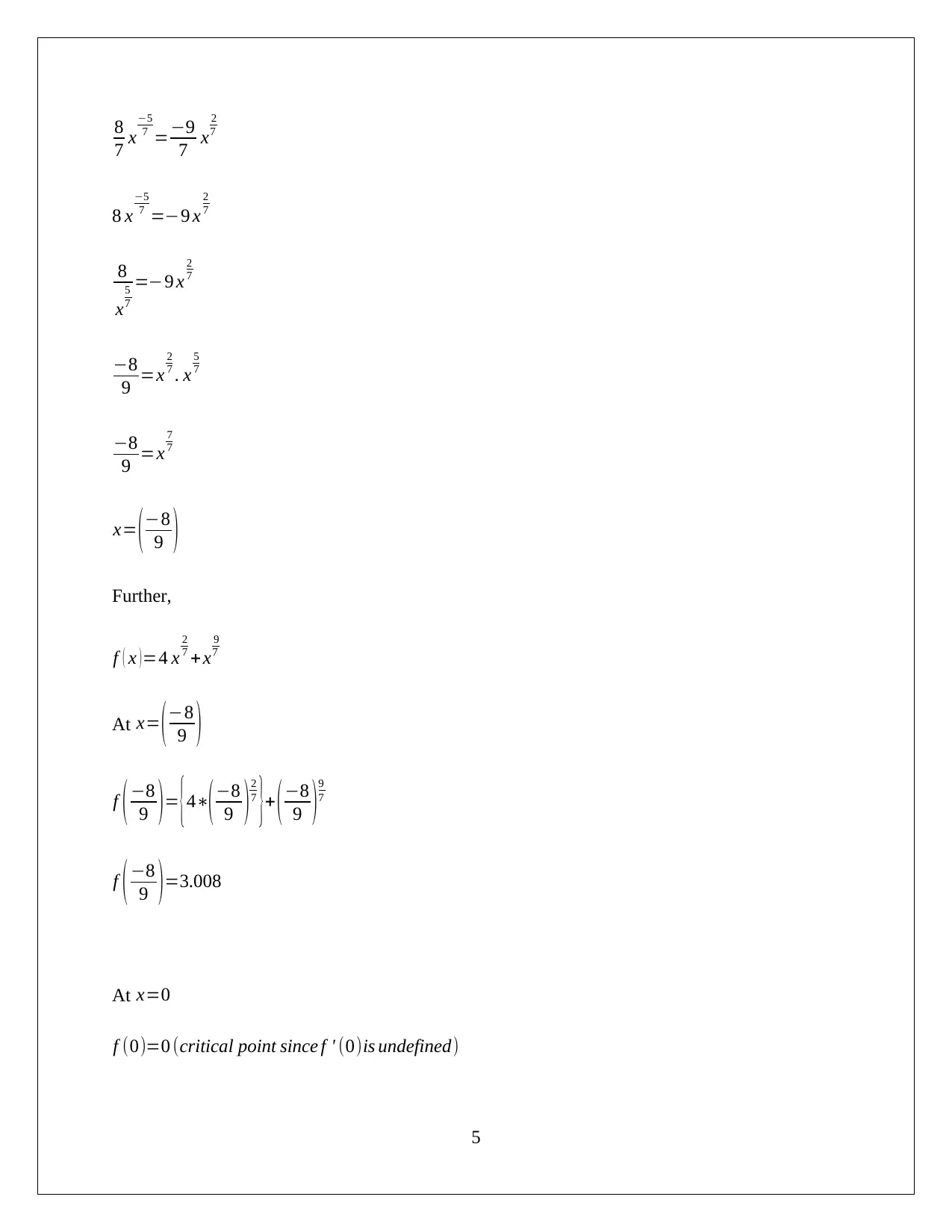
8
7 x
−5
7 =−9
7 x
2
7
8 x
−5
7 =−9 x
2
7
8
x
5
7
=−9 x
2
7
−8
9 =x
2
7 . x
5
7
−8
9 =x
7
7
x= (−8
9 )
Further,
f ( x )=4 x
2
7 + x
9
7
At x= (−8
9 )
f (−8
9 )= {4∗(−8
9 )2
7
}+ (−8
9 )9
7
f (−8
9 )=3.008
At x=0
f (0)=0 (critical point since f ' (0)is undefined)
5
7 x
−5
7 =−9
7 x
2
7
8 x
−5
7 =−9 x
2
7
8
x
5
7
=−9 x
2
7
−8
9 =x
2
7 . x
5
7
−8
9 =x
7
7
x= (−8
9 )
Further,
f ( x )=4 x
2
7 + x
9
7
At x= (−8
9 )
f (−8
9 )= {4∗(−8
9 )2
7
}+ (−8
9 )9
7
f (−8
9 )=3.008
At x=0
f (0)=0 (critical point since f ' (0)is undefined)
5
⊘ This is a preview!⊘
Do you want full access?
Subscribe today to unlock all pages.

Trusted by 1+ million students worldwide
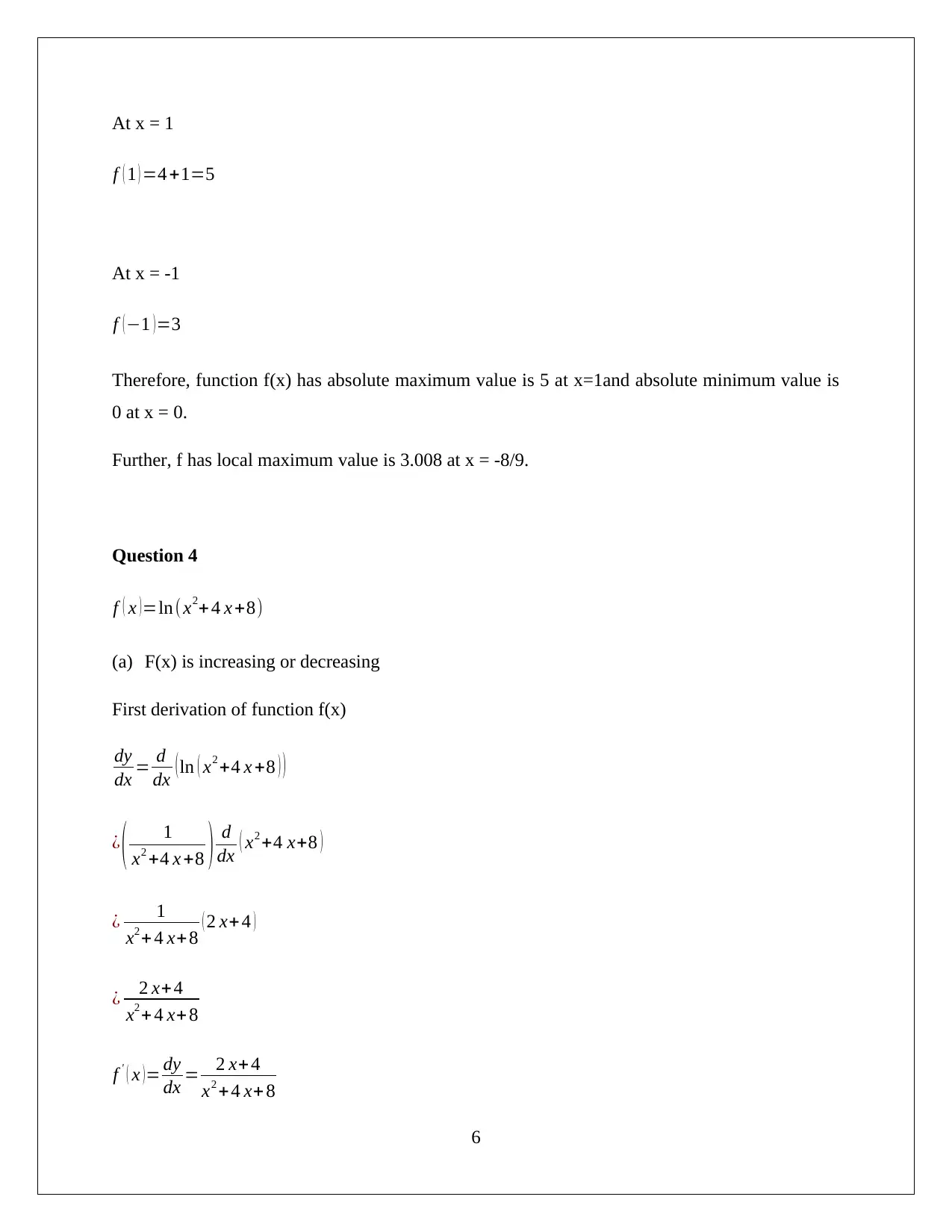
At x = 1
f ( 1 ) =4 +1=5
At x = -1
f (−1 )=3
Therefore, function f(x) has absolute maximum value is 5 at x=1and absolute minimum value is
0 at x = 0.
Further, f has local maximum value is 3.008 at x = -8/9.
Question 4
f ( x )=ln( x2+ 4 x +8)
(a) F(x) is increasing or decreasing
First derivation of function f(x)
dy
dx = d
dx (ln ( x2 +4 x +8 ) )
¿ ( 1
x2 +4 x +8 ) d
dx ( x2 +4 x+8 )
¿ 1
x2 + 4 x+8 ( 2 x+4 )
¿ 2 x+ 4
x2 + 4 x+ 8
f ' ( x )= dy
dx = 2 x+ 4
x2 + 4 x+ 8
6
f ( 1 ) =4 +1=5
At x = -1
f (−1 )=3
Therefore, function f(x) has absolute maximum value is 5 at x=1and absolute minimum value is
0 at x = 0.
Further, f has local maximum value is 3.008 at x = -8/9.
Question 4
f ( x )=ln( x2+ 4 x +8)
(a) F(x) is increasing or decreasing
First derivation of function f(x)
dy
dx = d
dx (ln ( x2 +4 x +8 ) )
¿ ( 1
x2 +4 x +8 ) d
dx ( x2 +4 x+8 )
¿ 1
x2 + 4 x+8 ( 2 x+4 )
¿ 2 x+ 4
x2 + 4 x+ 8
f ' ( x )= dy
dx = 2 x+ 4
x2 + 4 x+ 8
6
Paraphrase This Document
Need a fresh take? Get an instant paraphrase of this document with our AI Paraphraser
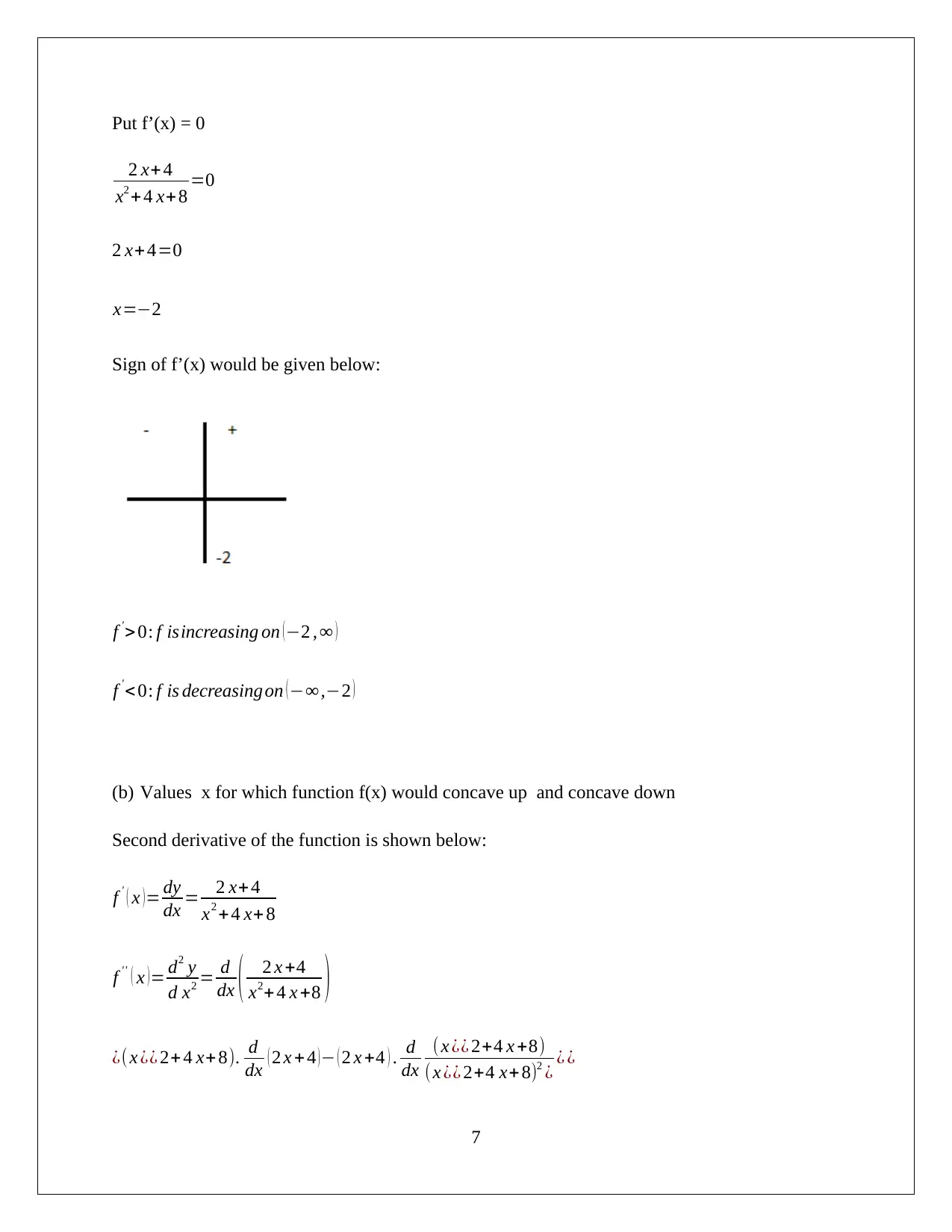
Put f’(x) = 0
2 x+ 4
x2 + 4 x+8 =0
2 x+ 4=0
x=−2
Sign of f’(x) would be given below:
f '> 0: f isincreasing on (−2 , ∞ )
f '< 0: f is decreasingon (−∞,−2 )
(b) Values x for which function f(x) would concave up and concave down
Second derivative of the function is shown below:
f ' ( x )= dy
dx = 2 x+ 4
x2 + 4 x+ 8
f '' ( x )= d2 y
d x2 = d
dx ( 2 x +4
x2+ 4 x +8 )
¿( x ¿¿ 2+ 4 x+ 8). d
dx ( 2 x + 4 ) − ( 2 x +4 ) . d
dx
( x ¿¿ 2+4 x +8)
(x ¿¿ 2+4 x+ 8)2 ¿ ¿ ¿
7
2 x+ 4
x2 + 4 x+8 =0
2 x+ 4=0
x=−2
Sign of f’(x) would be given below:
f '> 0: f isincreasing on (−2 , ∞ )
f '< 0: f is decreasingon (−∞,−2 )
(b) Values x for which function f(x) would concave up and concave down
Second derivative of the function is shown below:
f ' ( x )= dy
dx = 2 x+ 4
x2 + 4 x+ 8
f '' ( x )= d2 y
d x2 = d
dx ( 2 x +4
x2+ 4 x +8 )
¿( x ¿¿ 2+ 4 x+ 8). d
dx ( 2 x + 4 ) − ( 2 x +4 ) . d
dx
( x ¿¿ 2+4 x +8)
(x ¿¿ 2+4 x+ 8)2 ¿ ¿ ¿
7

¿ ( x ¿¿ 2+4 x +8) ( 2 ) − ( 2 x+4 ) ( 2 x+ 4 )
( x ¿¿ 2+ 4 x +8)2 ¿ ¿
¿ (2 x¿ ¿2+8 x +16)− ( 4 x2 +16 x+16 )
(x ¿¿ 2+4 x +8)2 ¿ ¿
¿ 2 x2 +8 x+16−4 x2−16 x−16
(x ¿¿ 2+4 x+ 8)2 ¿
¿ −2 x2−8 x
(x ¿¿ 2+4 x +8)2 ¿
f ' ' ( x ) = −2 x (x+ 4)
(x ¿¿ 2+4 x +8)2 ¿
Now, put f ' ' ( x )=0
−2 x ( x+4 )
( x ¿¿ 2+4 x +8)2=0¿
−2 x ( x +4 )=0
x=0 ,−4
Sign of f’(x) would be given below:
f ' ' >0: concave up on (−∞ ,−4 ) ∪ (0 , ∞)
8
( x ¿¿ 2+ 4 x +8)2 ¿ ¿
¿ (2 x¿ ¿2+8 x +16)− ( 4 x2 +16 x+16 )
(x ¿¿ 2+4 x +8)2 ¿ ¿
¿ 2 x2 +8 x+16−4 x2−16 x−16
(x ¿¿ 2+4 x+ 8)2 ¿
¿ −2 x2−8 x
(x ¿¿ 2+4 x +8)2 ¿
f ' ' ( x ) = −2 x (x+ 4)
(x ¿¿ 2+4 x +8)2 ¿
Now, put f ' ' ( x )=0
−2 x ( x+4 )
( x ¿¿ 2+4 x +8)2=0¿
−2 x ( x +4 )=0
x=0 ,−4
Sign of f’(x) would be given below:
f ' ' >0: concave up on (−∞ ,−4 ) ∪ (0 , ∞)
8
⊘ This is a preview!⊘
Do you want full access?
Subscribe today to unlock all pages.

Trusted by 1+ million students worldwide
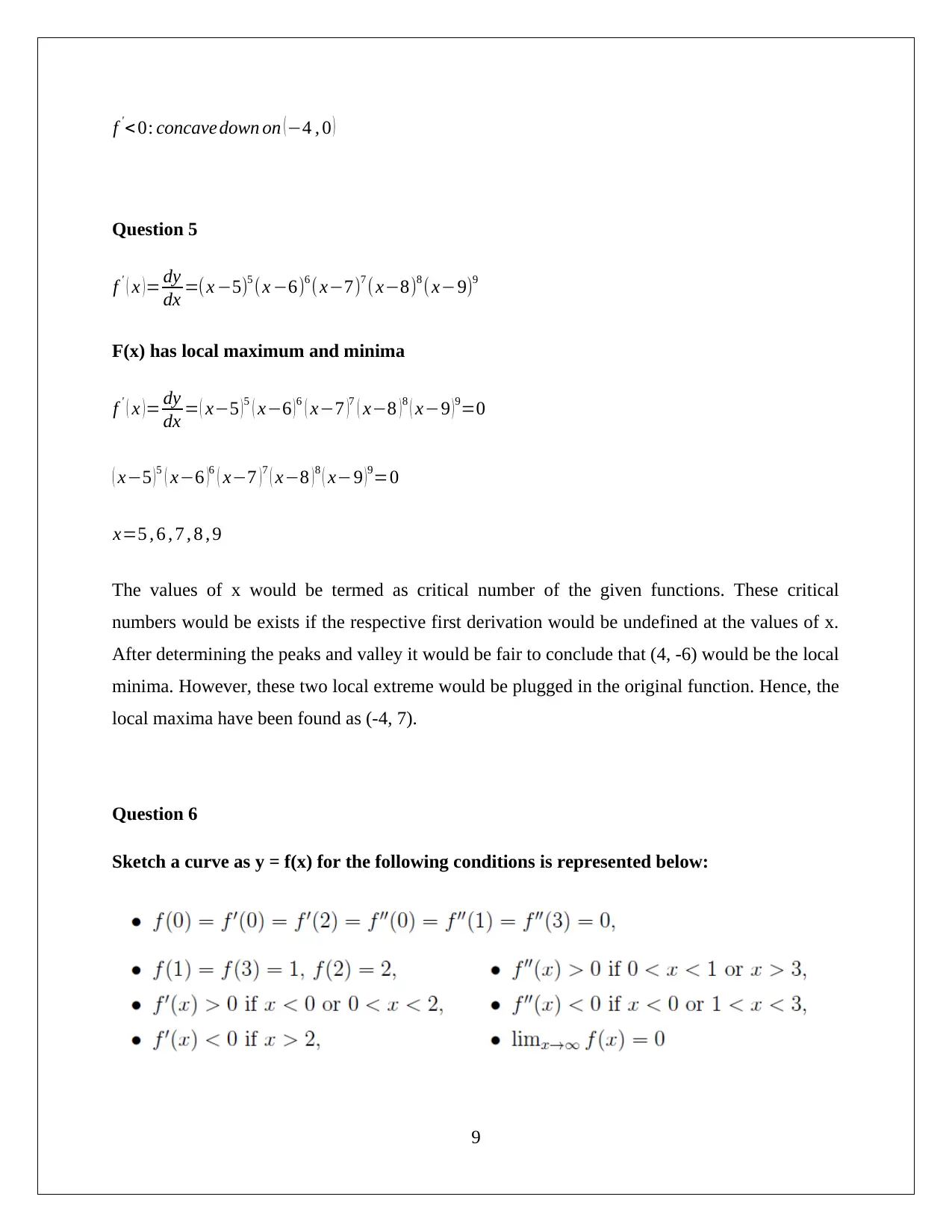
f '< 0: concave down on (−4 , 0 )
Question 5
f ' ( x )= dy
dx =(x −5)5 (x −6)6 ( x−7)7 ( x−8)8 ( x−9)9
F(x) has local maximum and minima
f ' ( x )= dy
dx = ( x−5 )5 ( x−6 )6 ( x−7 )7 ( x−8 )8 ( x−9 )9=0
( x−5 )5 ( x−6 )6 ( x−7 )7 ( x−8 )8 ( x−9 )9=0
x=5 , 6 , 7 , 8 , 9
The values of x would be termed as critical number of the given functions. These critical
numbers would be exists if the respective first derivation would be undefined at the values of x.
After determining the peaks and valley it would be fair to conclude that (4, -6) would be the local
minima. However, these two local extreme would be plugged in the original function. Hence, the
local maxima have been found as (-4, 7).
Question 6
Sketch a curve as y = f(x) for the following conditions is represented below:
9
Question 5
f ' ( x )= dy
dx =(x −5)5 (x −6)6 ( x−7)7 ( x−8)8 ( x−9)9
F(x) has local maximum and minima
f ' ( x )= dy
dx = ( x−5 )5 ( x−6 )6 ( x−7 )7 ( x−8 )8 ( x−9 )9=0
( x−5 )5 ( x−6 )6 ( x−7 )7 ( x−8 )8 ( x−9 )9=0
x=5 , 6 , 7 , 8 , 9
The values of x would be termed as critical number of the given functions. These critical
numbers would be exists if the respective first derivation would be undefined at the values of x.
After determining the peaks and valley it would be fair to conclude that (4, -6) would be the local
minima. However, these two local extreme would be plugged in the original function. Hence, the
local maxima have been found as (-4, 7).
Question 6
Sketch a curve as y = f(x) for the following conditions is represented below:
9
Paraphrase This Document
Need a fresh take? Get an instant paraphrase of this document with our AI Paraphraser

Question 7
Let
P ( a , b )∧Q ( c , d ) arethe two points on the given cubic
y=x3 + A
Where, 0<a<c
By using the mean value theorem that a point R (r, s) on PQ is such that tangent at R is || to chord
PQ.
y=x3 + A
10
Let
P ( a , b )∧Q ( c , d ) arethe two points on the given cubic
y=x3 + A
Where, 0<a<c
By using the mean value theorem that a point R (r, s) on PQ is such that tangent at R is || to chord
PQ.
y=x3 + A
10
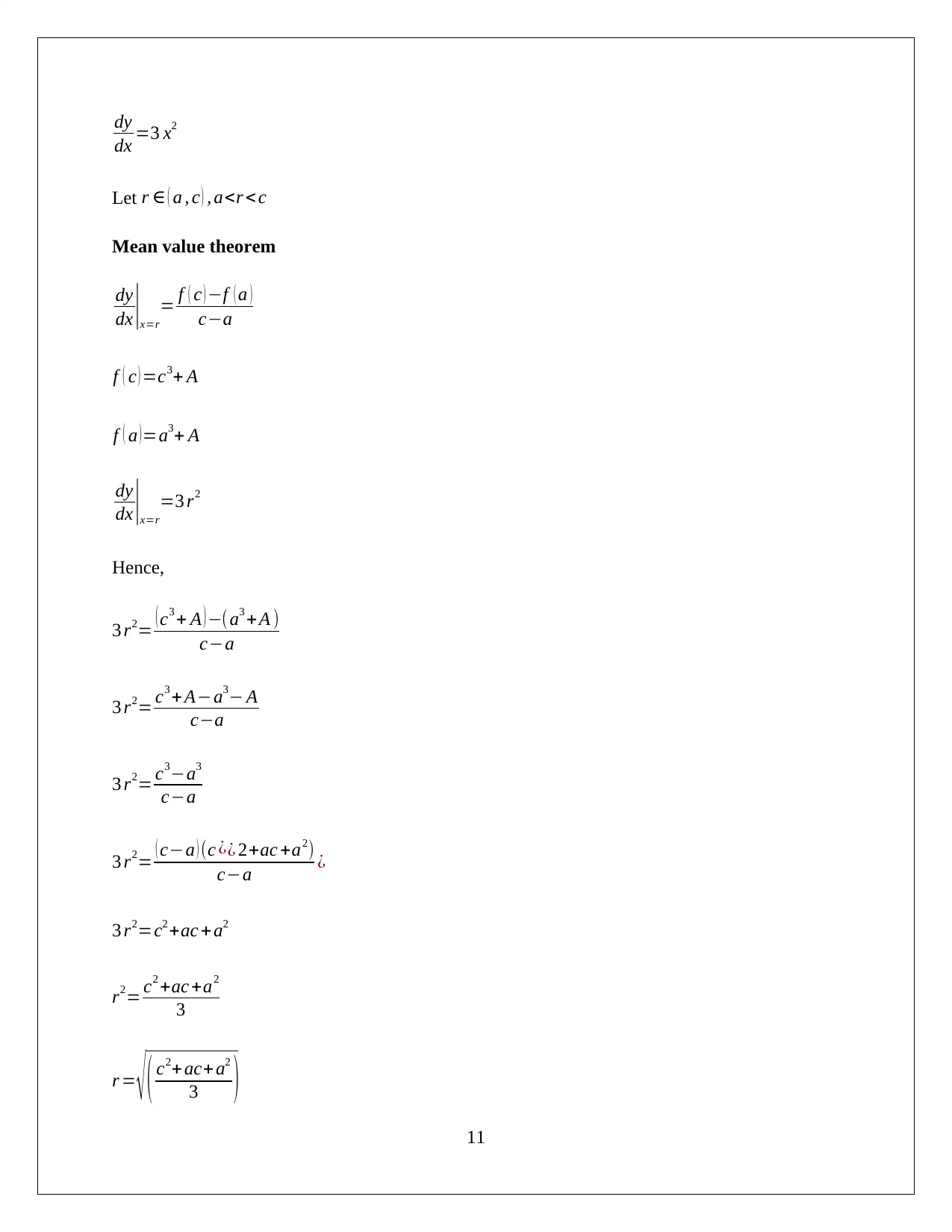
dy
dx =3 x2
Let r ∈ ( a , c ) , a<r < c
Mean value theorem
dy
dx |x=r
= f ( c ) −f ( a )
c−a
f ( c ) =c3+ A
f ( a ) =a3+ A
dy
dx |x=r
=3 r2
Hence,
3 r2= ( c3 + A ) −(a3 + A )
c−a
3 r2= c3 + A−a3− A
c−a
3 r2= c3−a3
c−a
3 r2= ( c−a ) (c ¿¿ 2+ac +a2)
c−a ¿
3 r2=c2 +ac + a2
r2= c2 +ac +a2
3
r = √ ( c2+ ac+ a2
3 )
11
dx =3 x2
Let r ∈ ( a , c ) , a<r < c
Mean value theorem
dy
dx |x=r
= f ( c ) −f ( a )
c−a
f ( c ) =c3+ A
f ( a ) =a3+ A
dy
dx |x=r
=3 r2
Hence,
3 r2= ( c3 + A ) −(a3 + A )
c−a
3 r2= c3 + A−a3− A
c−a
3 r2= c3−a3
c−a
3 r2= ( c−a ) (c ¿¿ 2+ac +a2)
c−a ¿
3 r2=c2 +ac + a2
r2= c2 +ac +a2
3
r = √ ( c2+ ac+ a2
3 )
11
⊘ This is a preview!⊘
Do you want full access?
Subscribe today to unlock all pages.

Trusted by 1+ million students worldwide
1 out of 20
Related Documents
Your All-in-One AI-Powered Toolkit for Academic Success.
+13062052269
info@desklib.com
Available 24*7 on WhatsApp / Email
![[object Object]](/_next/static/media/star-bottom.7253800d.svg)
Unlock your academic potential
Copyright © 2020–2025 A2Z Services. All Rights Reserved. Developed and managed by ZUCOL.



